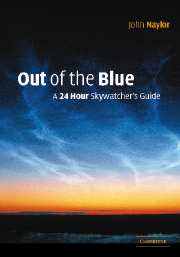Book contents
- Frontmatter
- Contents
- Preface
- Introduction
- 1 Daylight
- 2 Shadows
- 3 Mirages
- 4 Sunset and sunrise
- 5 Rainbows
- 6 Coronae and glories
- 7 Atmospheric halos
- 8 The night sky
- 9 The Moon
- 10 Eclipses
- 11 Planets
- 12 Stars
- 13 Comets and meteors
- APPENDIX: Technical and practical advice for skygazing
- Glossary
- Further reading
- Sources and notes
- Index
APPENDIX: Technical and practical advice for skygazing
Published online by Cambridge University Press: 14 August 2009
- Frontmatter
- Contents
- Preface
- Introduction
- 1 Daylight
- 2 Shadows
- 3 Mirages
- 4 Sunset and sunrise
- 5 Rainbows
- 6 Coronae and glories
- 7 Atmospheric halos
- 8 The night sky
- 9 The Moon
- 10 Eclipses
- 11 Planets
- 12 Stars
- 13 Comets and meteors
- APPENDIX: Technical and practical advice for skygazing
- Glossary
- Further reading
- Sources and notes
- Index
Summary
Estimating distance
There are several ways in which we estimate how far something is from us. In most situations we rely on our acquired knowledge of the relative size of things and on the fact that objects that are close to us can block out parts of objects that are further away. However, these clues work only in circumstances and with objects with which we are familiar. Furthermore light, colour and shape can trick our eyes. An object may look nearer than it really is, if it is either uphill or downhill from us, if it is bright, if it is seen across water or snow or if the atmosphere is particularly clear (see section 1.5). On the other hand, in poor light or if the colour of the object blends with its surroundings, it may appear to be further away.
Even with knowledge of relative size, without binocular vision judging distance would be difficult in some situations. Binocular vision works by fusing two slightly different viewpoints of the same scene to give us a sense of depth. The spacing between our eyes, however, is small and so binocular vision is unreliable beyond a distance of some 30 m. You can check this for yourself by looking at an object that is more than this distance from you and then checking whether there is an apparent shift between object and background when you close one eye.
- Type
- Chapter
- Information
- Out of the BlueA 24-Hour Skywatcher's Guide, pp. 300 - 305Publisher: Cambridge University PressPrint publication year: 2002

